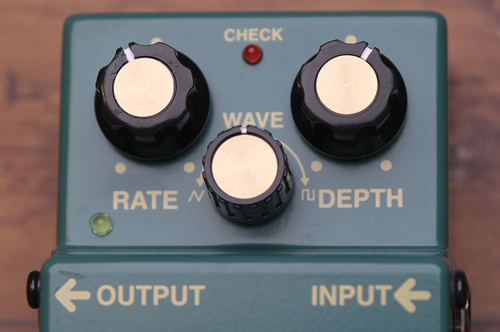As guitarists, we often find ourselves captivated by the countless ways in which we can shape and embellish our beloved instrument’s sound. From distortion to delay, reverb to wah-wah, the world of guitar effects pedals is a treasure trove of sonic possibilities.
Among these iconic tools lies one of the earliest effects to grace the guitar scene—the tremolo pedal. Widely recognized for its distinctive pulsating rhythm, the tremolo pedal etched its mark in the annals of music history, gaining particular popularity during the vibrant decades of the 1950s and 1960s when it first emerged.

So, what does a guitar tremolo pedal do, and why has it endured as a cherished staple in the arsenal of guitarists worldwide?
Tremolo Effect Explained
The tremolo effect works by rapidly and rhythmically varying the volume (amplitude) of the guitar’s signal. This creates a pulsating, wobbling, or trembling sound that adds depth and movement to the guitar’s tone. The effect is often described as a “shimmering” or “wavering” sound.
The guitar tremolo effect has been widely used in various musical genres, including rock, surf, blues, and indie music, among others. It adds a dynamic and hypnotic quality to the guitar sound and can be a versatile tool for creating different moods and atmospheres in music.
As well as in guitar pedal form, tremolo is also found in some amplifiers, particularly those made by Fender. Interestingly, they called the channel that had the tremolo effect the “Vibrato” channel.
The Fender Mix-up
The Leo Fender mix-up with the terms “vibrato” and “tremolo” is a fascinating part of electric guitar history. Leo Fender, the founder of Fender Musical Instruments Corporation, inadvertently mislabeled these terms on his guitar and amplifier designs.
It all started in 1954 with the introduction of the Stratocaster, when Leo Fender mistakenly referred to the pitch-modulating bridge system on his guitars as “tremolo.” The Stratocaster featured a revolutionary design with a bridge equipped with a unique arm that players could manipulate to alter the pitch of the notes. This arm, more commonly known as the “tremolo arm”, allowed guitarists to produce subtle or dramatic variations in pitch, adding an expressive and dynamic element to their playing.
To add further confusion to the story, the first Fender amp to incorporate a volume modulation effect was the Tremolux, which was launched in 1955 with a name that accurately reflected its tremolo effect. In addition, the dealer sheet correctly used the term tremolo. However, as Fender amplifiers began to include a dedicated channel for this effect, it was erroneously labeled as Vibrato, and this misnomer has persisted ever since.
The Difference Between Tremolo and Vibrato
In musical terms, here’s a breakdown of what these terms actually refer to:
- Vibrato: Vibrato is a musical effect that involves a slight variation in pitch. On a guitar, true vibrato is achieved by bending the pitch of a note up and down, giving it a “wobbling” or “shimmering” sound.
- Tremolo: Tremolo, in contrast to vibrato, refers to a fluctuation in volume or intensity. It involves rapidly altering the volume of a sound to create a pulsating effect.
For more information see our tremolo vs vibrato pedal article.
How do Tremolo Pedals Work?
The basic principle behind a tremolo pedal involves modulating the amplitude of the guitar signal, which means altering its volume up and down in a rhythmic pattern. There are various methods used to achieve this effect, with bias modulation and optical tremolo being common techniques employed in modern pedals.
Bias Modulation
Bias modulation is a traditional approach that alters the bias voltage of the audio signal. By adjusting the bias, the tremolo pedal creates a pulsating effect. This is how the Fender amp tremolo circuit works. This method often produces a smooth and natural sounding tremolo. It can generate different waveforms such as sine, triangle, or square waves.
Optical Tremolo
Optical tremolo employs a light-dependent resistor (LDR) to modulate the volume. The LDR is controlled by an internal light source, and as the light intensity changes, the resistance of the LDR fluctuates, resulting in variations in volume. Optical tremolo can offer unique tonal characteristics and a vintage vibe.
Tremolo Controls
Tremolo pedals come with various controls to shape the effect according to your preferences. Here are some commonly found controls:

- Rate / Speed: The rate or speed control adjusts the speed at which the volume modulation occurs. It determines how fast or slow the tremolo effect cycles.
- Depth / Intensity: The depth or intensity control sets the strength of the volume modulation. Increasing the depth results in a more pronounced and noticeable effect, while reducing it produces a subtler tremolo.
- Tap Tempo: Some more advanced tremolo pedals feature a tap tempo function. This control allows you to tap a button in time with your desired tempo, synchronizing the tremolo to match the rhythm of your music.
- Wave Shape: Certain tremolo pedals offer a wave shape control, which allows you to select the shape of the modulation waveform. Common options include sine waves, triangle waves, square waves, and sometimes even custom wave shapes.
How to Use a Tremolo Pedal: Tips and Tricks
Guitar tremolo pedals are versatile and dynamic tools that can add a mesmerizing pulsating effect to your guitar sound. Whether you want to create a subtle shimmer or a bold rhythmic texture, mastering the usage of a tremolo pedal can greatly enhance your guitar playing experience. In this section, we’ll explore some tips and tricks to make the most of your tremolo pedal and unlock its full potential:
1. Start with Subtle Settings
When using a tremolo pedal for the first time, it’s a good idea to start with subtle settings. Set the speed and depth controls to lower levels and play some chords or single notes. Gradually increase the depth and speed until you find the desired effect. Subtle tremolo can add a beautiful texture to your sound without overpowering it, especially when used with clean or slightly overdriven tones.
2. Sync with the Music
Tremolo effects work best when they synchronize with the rhythm of the music. Experiment with the speed control to match the tremolo’s pulsations with the tempo of the song. For slower songs, a more extended tremolo wave might be appropriate, while faster songs might benefit from quicker and tighter pulsations. Have a pedal with tap tempo obviously makes this job much easier.
3. Layering with Reverb and Delay
Combine your tremolo pedal with reverb and delay effects to create lush and atmospheric sounds. By placing the tremolo before the reverb and delay pedals in your signal chain, you can achieve a shimmering, ethereal ambiance. The combination of these effects can add depth and complexity to your guitar playing, making your sound more engaging and captivating.
4. Dynamic Playing
Experiment with your playing dynamics to enhance the tremolo effect. Picking harder or strumming with more intensity can emphasize the volume fluctuations, making the pulsations more pronounced. On the other hand, playing softly can create a more subtle and delicate tremolo effect.
5. Try Different Waveform Shapes
If your tremolo pedal offers different waveform shapes, don’t hesitate to experiment with them. Each waveform imparts a distinct sonic character, and certain shapes might suit specific musical genres or moods better than others.
Remember, mastering the tremolo pedal requires patience and experimentation. Take the time to explore various settings and combinations to find the sweet spots that suit your playing style and musical preferences. With these tips and tricks, you’ll be able to unleash the captivating power of the tremolo pedal and elevate your guitar playing to new heights.
What Famous Songs Use Tremolo?
Here’s collection of iconic songs that showcase the creative use of tremolo on the guitar.
- “How Soon Is Now?” by The Smiths: This iconic song by The Smiths uses a heavily tremolo-laden guitar riff to create a haunting and atmospheric atmosphere.
- “Crimson and Clover” by Tommy James and the Shondells: The guitar part in this song incorporates a tremolo effect, contributing to the dreamy and psychedelic vibe of the track.
- “Barracuda” by Heart: This classic rock anthem features a prominent guitar riff with a tremolo effect that adds a dynamic texture to the song.
- “Misirlou” by Dick Dale and His Del-Tones: This surf rock instrumental showcases Dick Dale’s fast-paced guitar playing, including the use of tremolo picking to create a vibrant and energetic sound.
- “Where Is My Mind?” by Pixies: The guitar in this song has a tremolo effect that adds a shimmering quality to the chords, enhancing the dreamlike and ethereal atmosphere.
- “Rumble” by Link Wray: This instrumental track is known for its raw and gritty guitar sound, achieved in part through the use of tremolo picking to create a pulsating rhythm.
- “Gimme Shelter” by The Rolling Stones: This classic rock track opens with a distinctive tremolo guitar riff that sets the tone for the entire song. The tremolo adds a sense of urgency and tension to the guitar part.
- “Born on the Bayou” by Creedence Clearwater Revival: In this bluesy rock song, CCR incorporates tremolo picking in the guitar parts, creating a pulsating rhythm that adds to the swampy and gritty atmosphere.
- “Boulevard of Broken Dreams” by Green Day: The guitar in this alternative rock hit uses a tremolo effect to give the chords a wavering and slightly distorted sound, contributing to the introspective and melancholic mood of the song.
- “Guitar Town” by Steve Earle: As the title suggests, this country-rock song prominently features guitar work. The tremolo effect is applied to add a touch of twang and modulation to the guitar, enhancing the country feel of the track.
This represents just a fraction of the vast selection of the many songs that beautifully showcase the tremolo sound.
Conclusion
From its humble beginnings in early amplifiers to the modern pedal innovations, this timeless effect continues to inspire musicians across genres and generations.
Whether you’re after a vintage vibe or modern innovation, the tremolo pedal is a timeless source of inspiration for guitar players across genres.
Whether you want to add a subtle shimmer or create an intense pulsating sound, a tremolo pedal can greatly enhance your playing experience. So why not give it a try? Explore the possibilities that a tremolo pedal offers and take your guitar playing to new heights.
Along with my delay pedal this is one of my favourite effects. If you’ve not tried one then why not try a tremolo pedal – you won’t be disappointed with expressive possibilities it brings to your playing.
